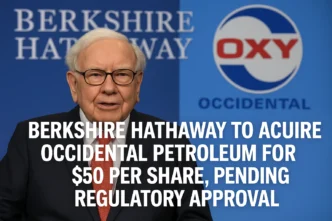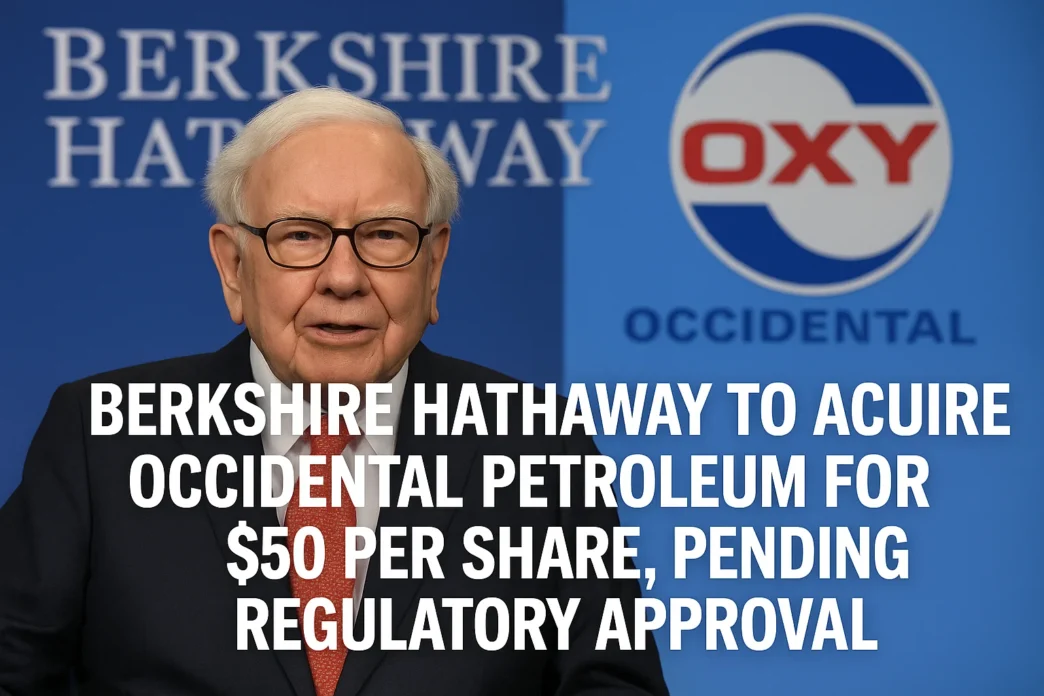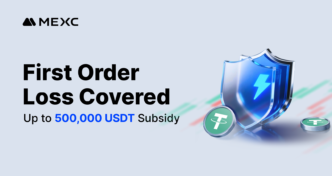Update, Oct 15, 2025: The source of this information has updated their original statement and stated that the acquisition of Occidental Petroleum can’t be 100% confirmed via official channels.
Update, Oct 16, 2025: The source of this information says that, although the deal isn’t 100% guaranteed, the $50/share price is a minimum and the range is $50-$60 that Berkshire is considering.
Update, Oct 16, 2025 (11:43 am PT): We asked the source to reveal their contact information so it can be added to this article, but they fear getting fired and have asked us not to share it. They confirmed that the $50-$60 price per share is still under consideration.
Sources report that Berkshire Hathaway has agreed to acquire all outstanding shares of Occidental Petroleum (OXY) at $50 per share, a move that would fold one of America’s most storied independent oil and gas producers into Warren Buffett’s conglomerate, subject to regulatory approval. The all-cash offer values Occidental at the mid-$40 billion on an equity basis, placing a premium on the company’s recent trading range and reflecting Berkshire’s conviction in long-duration U.S. energy assets, stable cash generation, and the optionality of emerging carbon management businesses.
The proposed transaction would mark one of Berkshire’s largest industrial deals and a defining energy bet for Buffett’s successor bench. It also caps a multi-year courtship in which Berkshire steadily increased its stake in Occidental, signaling confidence in the company’s Permian Basin footprint, its chemicals adjacency, and management’s disciplined capital framework.
Why $50 a Share?
The $50 figure strikes a calculated balance: high enough to win shareholder support without overpaying for a commodity-exposed business. Occidental’s investment case has long hinged on three levers: low-cost Permian inventory, integrated cash engines like OxyChem, and an increasingly credible plan to de-risk the balance sheet while returning capital. At $50, Berkshire is effectively underwriting a cycle-average oil scenario, not the top of the market, and paying for durable free cash flow rather than short-term price spikes. The price also acknowledges Occidental’s improved cost structure since 2020 and the step-downs in interest expense from ongoing debt reduction.
From Occidental’s perspective, $50 provides certainty of value against a volatile macro backdrop. Oil has been a whipsaw; service costs, while easing, remain unpredictable; and the market has penalized E&Ps that balance growth with decarbonization investments. A full cash takeout removes that volatility discount and rewards shareholders who endured years of deleveraging after major acquisitions.
Berkshire’s Motivation: Cash Machines, Moats, and Manageable Risk
Berkshire’s playbook is hiding in plain sight:
- Durable Cash Flow: Occidental’s upstream portfolio in the Permian Basin sits on top-tier rock with decades of drilling runway. Decline curves, pad drilling efficiencies, and a maturing water/CO₂ handling network allow for predictable free cash flow at mid-cycle prices. Berkshire favors businesses where operational control translates into reliable cash generation, the same logic that underpins its utilities, rails, and manufacturing holdings.
- Option Value in Carbon and Chemicals: Occidental’s long-term bet on carbon capture, utilization, and storage (CCUS), including direct air capture and CO₂-EOR synergies, offers genuine optionality. Buffett doesn’t chase moonshots, but he respects asymmetric payoff profiles embedded in otherwise steady businesses. If federal incentives and corporate offtake contracts continue to firm up, carbon management could become a second engine, not just a hedge.
- Integration Without Empire-Building: Berkshire’s decentralized model lets strong operators keep running their businesses with minimal HQ interference. Occidental’s leadership gets long-horizon capital and insulation from quarterly market noise, while Berkshire gets diversification and pricing power dynamics that rhyme with its experience in energy and industrials.
- Risk That Berkshire Knows How to Price: Capital intensity and commodity risk don’t scare Berkshire; bad governance and shaky balance sheets do. Occidental has done the hard yards on debt and portfolio focus. Folding that into Berkshire’s fortress balance sheet compresses refinancing risk and lowers the corporate cost of capital, value that accrues day one.
Deal Structure and Financing
While Berkshire has ample liquidity and recurring cash from its operating subsidiaries, the all-cash framing also signals confidence and speed. Cash avoids stock-for-stock debates, simplifies shareholder math, and minimizes closing risk. Berkshire’s ability to finance from cash on hand and modest debt issuance, if needed, keeps the story clean.
Expect Occidental to operate as a largely standalone subsidiary, consistent with Berkshire’s norm. Compensation plans tied to capital efficiency, safety, emissions intensity, and free cash flow conversion are likely to stay intact. The chemicals arm remains strategically relevant as a cash and margin stabilizer through the cycle, smoothing upstream volatility, another trait Buffett prizes.
Regulatory Path: What Could Slow (But Not Stop) the Deal
The transaction is subject to regulatory approval, primarily under the Hart-Scott-Rodino Act in the U.S. Because Berkshire is a diversified holding company, not a competing upstream producer, horizontal concentration concerns are limited. The main review threads will be:
- Energy Market Concentration (Vertical & Portfolio Effects): Regulators will evaluate whether Berkshire’s collection of energy assets could influence regional pricing, pipeline access, or service competition. That’s a low-probability obstacle given the fragmentation of U.S. upstream and midstream markets.
- Climate and Environmental Scrutiny: Occidental’s CCUS portfolio and CO₂-EOR linkage may draw questions, but this is more about disclosure and compliance than antitrust. If anything, Berkshire’s longer horizon and deeper pockets could accelerate environmental remediation and emissions-reduction plans.
- Foreign Investment & National Security: With both parties American and assets largely domestic, CFIUS review should be perfunctory unless specific leases or technologies trigger attention. Not impossible, but unlikely to be a deal breaker.
Net net: timing, not viability, is the biggest regulatory variable. Expect a standard second request and a several-month review, with closing targeted after those customary steps.
Strategic Upshot for the Energy Landscape
Berkshire’s move re-rates the strategic value of scale onshore portfolios. It signals to the market that long-life, low-cost barrels in stable jurisdictions are still crown-jewel assets, even in an energy transition. Several implications follow:
- M&A Ripple Effects: Supermajors and large independents will revisit their portfolio math to concentrate further in the Permian, double down on LNG integration, or bolt on carbon storage acreage to secure a seat in the low-carbon value chain. A Berkshire seal of approval can pull forward bids on second-tier assets chasing the same investor narrative: stable, repeatable free cash flow.
- Cost of Capital Divergence: Inside Berkshire, Occidental gains a structural funding advantage. Outside Berkshire, E&Ps with similar inventory depth but weaker balance sheets could see their relative cost of capital rise. The market will reward those who can self-fund capex, return cash, and still invest credibly in emissions intensity reduction.
- Carbon Markets Maturation: With Berkshire’s brand behind CCUS monetization, counterparties, from airlines to materials companies, may be more willing to sign longer-dated carbon offtake agreements. That demand visibility could catalyze financing for shared CO₂ infrastructure, accelerating the move from pilots to platforms.
Winners, Risks, and the Real Work Ahead
Winners: Occidental shareholders gain certainty and a premium. Berkshire shareholders get a cash-rich, asset-heavy business that can compound for decades, plus upside if carbon monetization scales. U.S. energy supply security benefits from long-term ownership that isn’t forced into short-term production swings by Wall Street mood swings.
Risks: It’s still oil. A prolonged downturn would test returns, and service costs can creep. Carbon revenue remains policy-sensitive; if incentives waver or measurement standards tighten too quickly, ramp-up timelines could slip. Integration risk is low for Berkshire, but talent retention and project cadence are real execution variables.
Mitigations: Berkshire’s decentralized autonomy preserves Occidental’s operating rhythm. Conservative price decks in deal underwriting, a relentless focus on well economics, and staged CCUS investments tied to contracted demand all help buffer downside. And Berkshire’s patient capital can lean into cycles, buying when others can’t, to keep returns attractive.
What to Watch Next
- Regulatory milestones: HSR filing, any second request, and closing conditions.
- Capital allocation signals: Post-close priorities on drilling cadence, buybacks (at the Berkshire level), and CCUS FIDs tied to contracted volumes.
- Operational KPIs: Permian well productivity, base decline management, LOE and D&C cost trends, and cash conversion.
- Carbon commercialization: Additional long-term offtake agreements, clarity on sequestration hubs, and third-party volumes moving through Oxy-operated CO₂ systems.
Bottom line: Berkshire isn’t paying $50 per share to time a quarter. It’s buying an American cash engine with real assets, real options, and real durability. If regulators sign off, and they likely will after the usual scrutiny, this will be remembered less as a gamble on oil and more as a bet on disciplined operations, advantaged geology, and a pragmatic bridge between today’s energy system and tomorrow’s.














